the iconic stadium is showing signs of wear and tear.
Football continues to evolve but what about Premier League stadiums and how they will look in 100 years?
This has sparked curiosity about the potential transformations.
Betting Sites has used the AI software Midjourney to envision the possible future appearances of Premier League stadiums in the 2100s.
Certain English top-flight clubs have already initiated renovations on their existing stadiums or embarked on the construction of futuristic replacements, hoping to ensure their endurance over time.
Predicting the architectural landscape of 2123 is effectively impossible. Nevertheless, AI has offered its interpretations for some of the Premier League’s top teams.
As Manchester United’s Old Trafford rots, these visual representations might ignite optimism among fans eagerly anticipating state-of-the-art facilities.
Manchester United
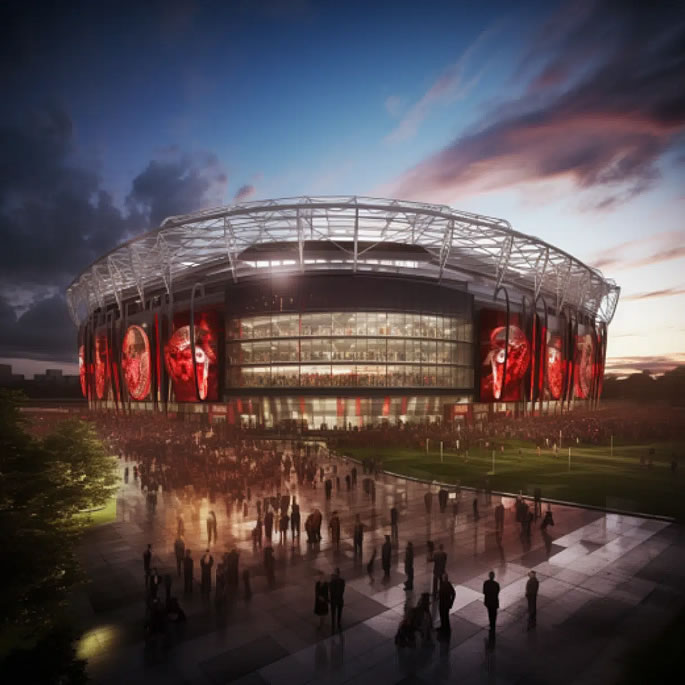
Officially opened in 1910, Old Trafford remains a hallmark of English football.
However, the structure has begun to deteriorate.
During the Manchester derby in October 2023, chants of “Old Trafford is falling down” echoed through the away end, encapsulating the perception that the iconic stadium is showing signs of wear and tear.
Reflecting its age in every aspect, there were even reports of a group of fans experiencing the unsettling occurrence of concrete pieces falling during the current season.
Responding to these concerns, the newly appointed shareholder, Sir Jim Ratcliffe, has assured the infusion of necessary capital to facilitate significant improvements to Manchester United’s historic and spiritual home.
The commitment to rejuvenate Old Trafford is not merely a promise to address structural concerns but also an acknowledgement of its symbolic significance to the club and its supporters.
The prospect of a revitalised Old Trafford, as envisaged by artificial intelligence, adds a layer of anticipation.
If the outcome aligns with the AI-generated depictions, the future iteration of Old Trafford promises to be a visually stunning and technologically advanced marvel.
Arsenal
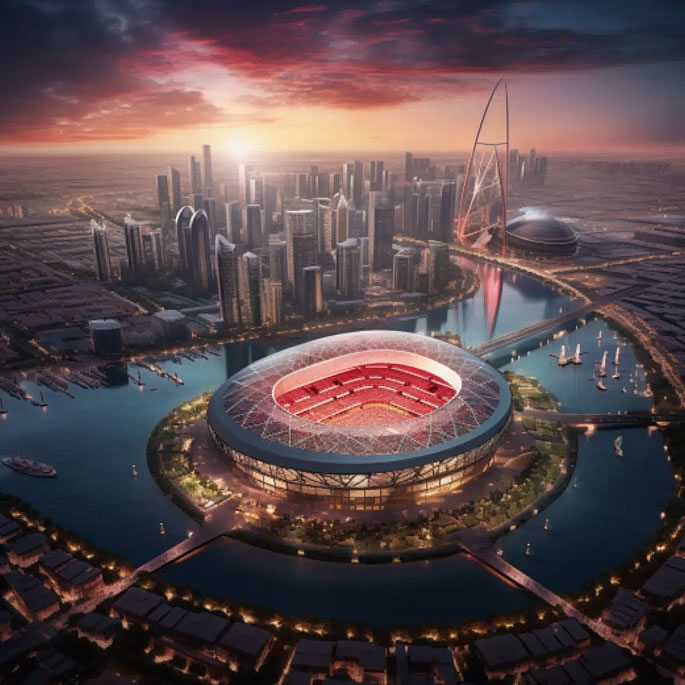
Arsenal’s Emirates Stadium has been open since 2006 so it is unlikely that the London club will get a new home in the foreseeable future.
But in the 2120s, AI has given the Emirates Stadium a huge transformation that gives the impression of having relocated to the United Arab Emirates.
The once-familiar football arena now showcases breathtaking water features that bear a striking resemblance to the iconic Palm Island in Dubai.
This infusion of architectural inspiration from a distant locale adds a futuristic and exotic touch to the stadium’s aesthetic.
The change extends beyond the confines of the stadium to the surrounding neighbourhoods.
The charming and traditional townhouses of Highbury and Islington, which once defined the area’s character, seem to have yielded to the march of progress.
In their place now stands audaciously designed skyscrapers, introducing a new skyline dominated by modern and perhaps unconventional architectural choices.
The juxtaposition of these bold skyscrapers against the backdrop of the Emirates Stadium creates a visual panorama that reflects the dynamic evolution of the urban landscape into a realm of avant-garde design and contemporary style.
Liverpool
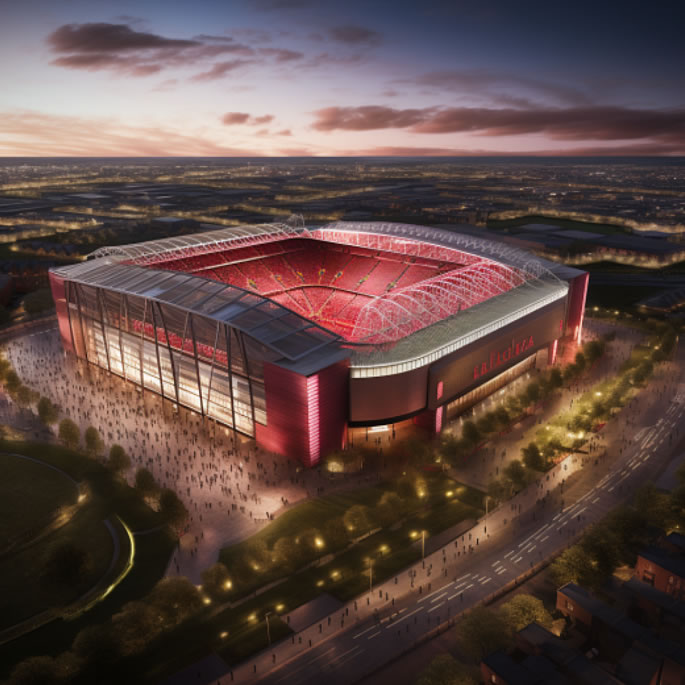
While a complete overhaul of the cherished Anfield seems unlikely, especially given the steadfast loyalty of the Liverpool fanbase, there are subtle yet discernible changes by the year 2123.
Rather than opting for a drastic transformation, the modifications lean towards cosmetic facelifts that delicately enhance the stadium’s visual appeal.
These adjustments, along with a nuanced approach, are likely aimed at preserving the essence and historical significance of Anfield while introducing contemporary elements to keep pace with evolving architectural trends.
The careful balance struck between tradition and modernity reflects a conscientious effort to honour the sentiments of the fanbase, ensuring that Anfield retains its timeless charm while adapting to the demands of the future.
Therefore, the AI-generated stadium showcases a blend of Anfield’s storied past and the ever-changing landscape of football aesthetics.
Manchester City

Concrete plans have been set in motion to transform the Etihad Stadium into a multifaceted entertainment hub, marking a strategic move beyond its traditional role as a football arena.
The vision for this transformation aims to turn the stadium into an all-encompassing centre for various forms of entertainment, signalling a comprehensive integration of cultural and leisure experiences.
But AI has predicted that Manchester City’s home will boast an exceptionally colossal capacity a century from now.
This prediction hints at the anticipation of a monumental expansion, suggesting a future where the stadium’s scale transcends contemporary boundaries.
Yet, the lingering question remains about the atmosphere within the transformed Etihad.
As the capacity potentially swells with an even greater influx of fans, there arises a curiosity about whether the stadium’s ambience will persist in its current quiet demeanour or undergo a shift in dynamic energy.
Tottenham

Similar to their North London rivals, AI has predicted a substantial transformation for Tottenham Hotspur.
It gives the impression of either a relocation or the intentional creation of a verdant oasis right in the heart of the Little Russia and Park Lane area.
The visual alteration prompts intrigue, as the landscape that was once associated with the hustle and bustle of urban life now appears to house a forest, injecting a touch of nature into the cityscape.
The juxtaposition of a football stadium against the backdrop of what seems to be a thriving green expanse adds an unexpected element to the familiar surroundings.
Amid this AI prediction is the presence of fireworks.
Although the reason for the fireworks remains a mystery, it could also be a prediction that Tottenham has secured a coveted trophy.
Newcastle United
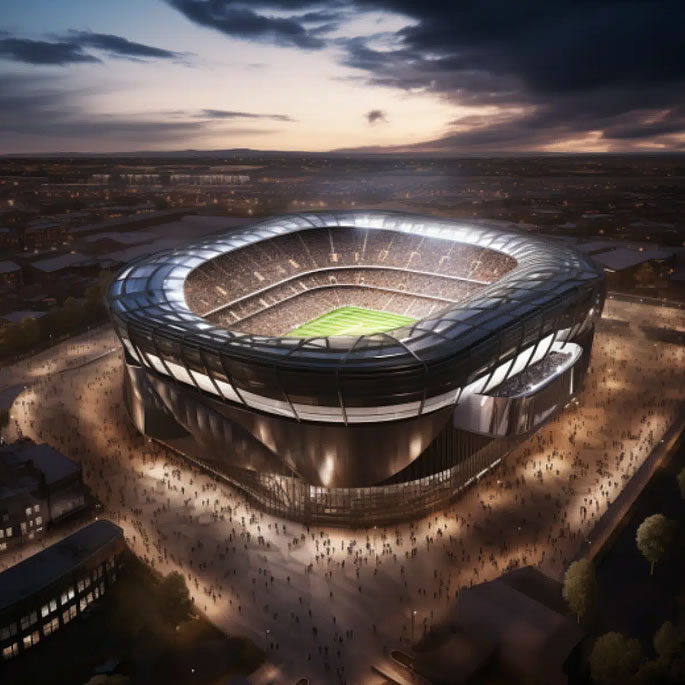
Newcastle United’s St James’ Park is one of the rare city-centre stadiums in England and there are talks that the iconic stadium could be demolished and replaced by a completely new ground.
AI has predicted that there is an apparent departure from the constraints of its current urban setting.
But the most striking observation revolves around the staggering scale of the stadium.
It appears to have undergone a substantial enlargement, with a notable emphasis on the Milburn Stand and Leazes End.
In this futuristic rendition, it’s almost as if the architects and planners decided to magnify the already towering structures, allowing them to gracefully envelop the entire perimeter of the stadium.
The effect is nothing short of awe-inspiring, as the architectural embrace seems to redefine the very skyline that surrounds St James’ Park.
The visual narrative hints at a future where the stadium transcends its current boundaries, both in sheer size and the impact it has on the urban landscape.
Chelsea
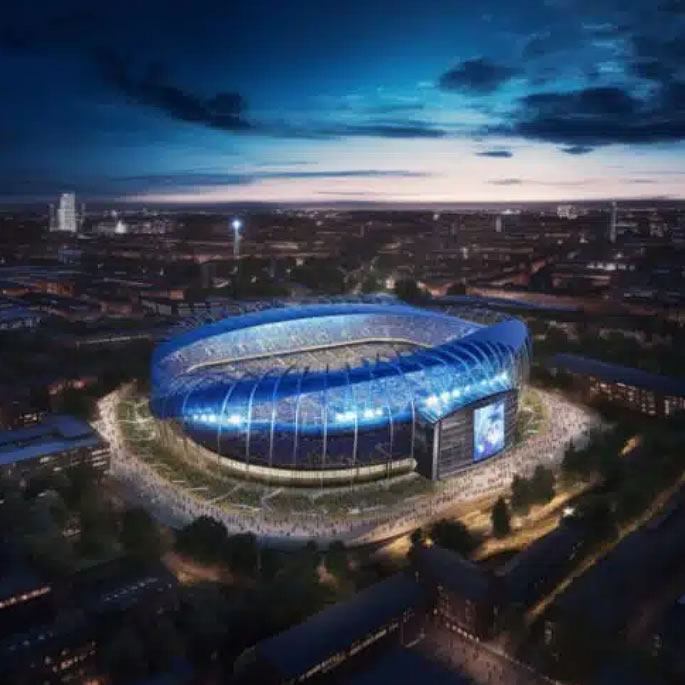
It appears Chelsea will have transitioned into an entirely new and upgraded home by the turn of the 22nd century.
The transformation is nothing short of spectacular, and the location of this redesigned stadium, although undisclosed, radiates an undeniable allure.
In the 2100s, the Chelsea home ground exudes an air of magnificence and sophistication, leaving spectators in awe of its architectural grandeur.
The exterior hints at a meticulous blend of modern aesthetics and technological advancements, suggesting a commitment to creating a stadium that caters to football’s practicalities and is a testament to Chelsea’s aspirations for excellence.
The mysterious beauty of this revamped Stamford Bridge leaves enthusiasts with a sense of wonder.
West Ham United

West Ham United only moved to the London Stadium in 2016 so an AI prediction is only subtle.
The architectural alterations hint at a slight increase in height and a more squared-off profile, suggesting a nuanced shift in the stadium’s overall structure.
A noteworthy aspiration voiced by fans is a desire to be closer to the pitch.
The precise changes, combined with the hope for increased intimacy with the playing field, indicate a commitment to enhancing the fan experience.
This small yet deliberate approach to stadium modifications showcases a desire to strike a delicate balance between preserving the stadium’s existing identity and responding to the evolving expectations and desires of spectators.
Everton
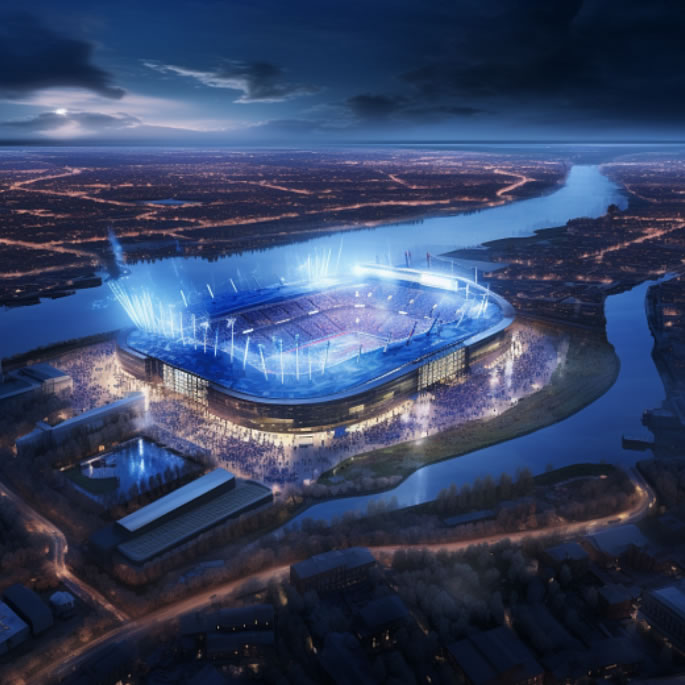
The envisioned outcome closely mirrors what Everton anticipates for their state-of-the-art Bramley-Moore Dock site, scheduled to be completed at the start of the 2024/25 season.
The ambitious project encompasses a comprehensive vision, encapsulating the architectural, infrastructural, and aesthetic aspects of the new site.
Everton fans are eagerly awaiting the realisation of this modern footballing haven.
The Bramley-Moore Dock site is not merely a construction project; it’s a meticulous plan that considers every facet, from the layout of the stadium to the surrounding amenities.
As the envisioned completion date approaches, there is a sense of anticipation and excitement surrounding the prospect of Everton’s new home.
Aston Villa

Aston Villa are flying in the 2023/24 Premier League but how could Villa Park look in 100 years?
This AI-generated image makes the stadium appear to resemble a university campus.
But the depiction infers a sense of uncertainty as if the envisioned changes might not entirely align with the expectations or traditions associated with Villa Park.
The contemplation prompts a closer examination of the proposed alterations, challenging the conventional notions tied to a football stadium.
It sparks curiosity about how this potential transformation might redefine the identity of Villa Park, blurring the lines between a cherished footballing venue and an educational institution.
By looking at AI images of how some of the Premier League’s top stadiums might look in 100 years, they provide an insight into what the future holds for football.
As we peer into the future, the diverse interpretations of iconic stadiums leave us with a variety of possibilities – from lush green oases to towering structures seamlessly integrated into urban landscapes.
These AI-generated visions challenge our preconceptions of what a football stadium can be, prompting us to reflect on the dynamic relationship between tradition and innovation.
Whether these projections materialise or remain confined to the realm of speculation, the journey itself becomes a testament to the boundless possibilities that lie ahead for the ever-evolving world of football.






























































